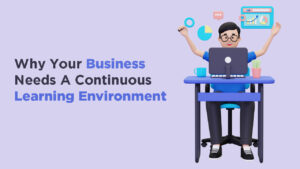In today’s rapidly evolving business landscape, technological advancements and shifting work environments present unprecedented opportunities for organizations willing to embrace change. Traditional learning methods are no longer sufficient—businesses must adopt agile, continuous learning strategies to remain competitive. A growth mindset is critical to building a learning-driven organization, ensuring that employees stay adaptable, innovative, and ready to navigate change.
Organizations play a pivotal role in fostering this mindset by creating an environment that encourages continuous learning and professional development. A strong learning culture not only enhances workforce agility but also strengthens overall business resilience. By prioritizing learning and making knowledge accessible when and where it is needed, businesses empower employees to evolve, improve performance, and contribute to long-term success.
What is a Learning Culture?
A learning culture refers to an organizational environment where values, processes, and practices actively support employee development and continuous skill enhancement. It goes beyond traditional training by integrating learning into everyday work experiences. When employees are encouraged to expand their knowledge and refine their skills, they become more engaged, innovative, and aligned with organizational goals.
Below are key reasons why investing in a learning culture is crucial for modern businesses.
The Benefits of a Strong Learning Culture
1. Attract and Retain Top Talent
Employee retention is a growing challenge, and high turnover can lead to significant financial and operational setbacks. Today’s workforce seeks more than just a paycheck—employees value organizations that invest in their growth and career development.
A strong learning culture serves as a powerful talent magnet, demonstrating to prospective hires that an organization prioritizes professional development. For existing employees, continuous learning opportunities enhance job satisfaction, promote career progression, and increase long-term retention. Organizations that invest in employee growth build a motivated workforce that remains committed to achieving business success.
2. Enhance Customer Satisfaction
Customer experience is directly linked to employee engagement and expertise. Organizations with a well-developed learning culture equip employees with the necessary knowledge, skills, and confidence to deliver superior customer service.
Continuous learning helps employees better understand customer needs, refine their communication strategies, and offer tailored solutions. When employees are motivated and well-informed, they are more likely to go the extra mile, leading to improved customer satisfaction, stronger relationships, and increased brand loyalty.
3. Improve Employee Performance and Productivity
An organization’s success depends on the competency and efficiency of its workforce. A culture of continuous learning ensures that employees acquire new skills, stay updated with industry trends, and refine their problem-solving abilities.
Encouraging ongoing development fosters a knowledge-sharing mindset, where employees support each other’s growth. As a result, organizations benefit from a workforce that is more agile, innovative, and productive. Employees who feel supported in their learning journey are also more engaged, motivated, and aligned with business objectives.
4. Foster Innovation and Adaptability
Innovation is a key differentiator in today’s highly competitive market. Organizations that prioritize learning encourage employees to think creatively, challenge existing processes, and develop innovative solutions to business challenges.
A learning culture promotes experimentation and resilience, allowing employees to learn from failures and refine their approach. Companies that invest in a strong learning ecosystem are better equipped to navigate industry shifts, embrace new technologies, and stay ahead of competitors.
5. Strengthen Competitive Advantage
An organization’s workforce is its greatest asset and a key driver of competitive success. To thrive in a rapidly changing business environment, companies must ensure that employees possess the necessary skills, knowledge, and confidence to adapt and excel.
Businesses with a well-established learning culture are more agile and responsive to market demands, empowering employees to develop innovative strategies and exceed customer expectations. Additionally, a strong emphasis on learning cultivates a sense of personal value and commitment among employees, resulting in higher efficiency, performance, and profitability.
Building a Learning Culture: A Strategic Imperative
To establish a successful learning culture, organizations must integrate learning into their core values and operational strategies. Key steps include:
✔ Identifying Learning Gaps – Assessing workforce skill levels and determining areas for improvement.
✔ Developing Engaging Training Programs – Implementing diverse learning methods such as eLearning, mentorship, and hands-on experiences.
✔ Encouraging Continuous Learning – Fostering an environment where employees take ownership of their professional development.
✔ Providing Accessible Learning Resources – Ensuring employees have the tools and flexibility to learn at their convenience.
Conclusion
In an era of constant change, continuous learning is no longer optional—it is essential for business survival and growth. A well-established learning culture enables organizations to develop top talent, enhance customer satisfaction, drive innovation, and maintain a competitive edge.
By prioritizing employee development and knowledge sharing, businesses create a dynamic work environment where individuals thrive, and the organization prospers. Investing in a learning culture is a strategic decision that fuels long-term success, adaptability, and industry leadership.
Is your organization ready to embrace a culture of continuous learning? Now is the time to invest in the future of your workforce.






